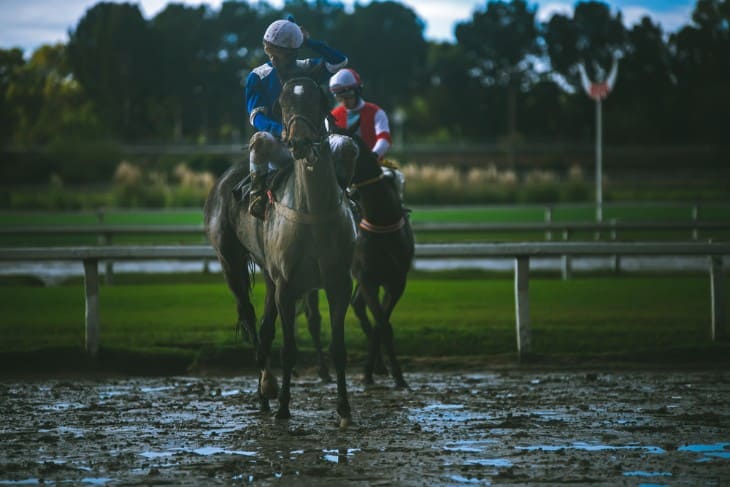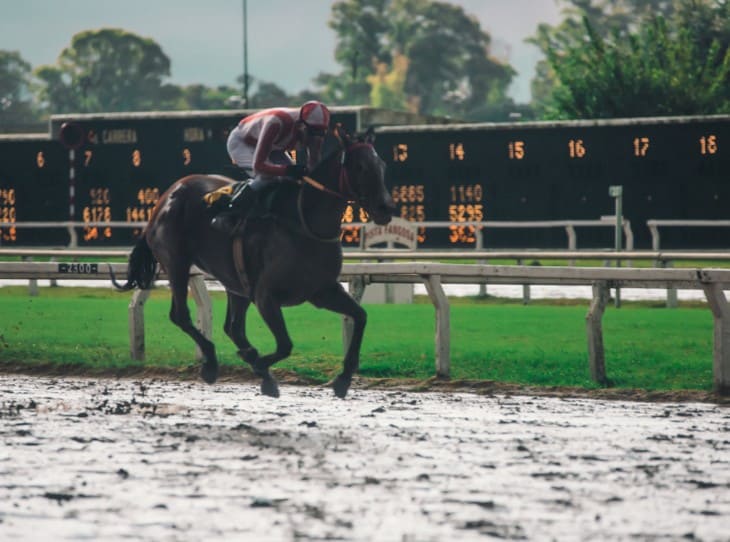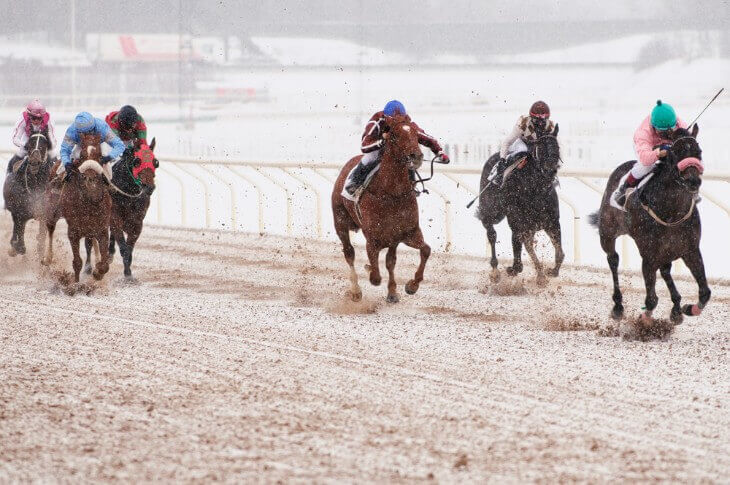- The Influence of Rain on Horse Racing Performance
- The Impact of Heat and Humidity on Race Horses
- Wind: Friend or Foe in Horse Racing
- Snow and Cold Weather Effects on Horse Races
- Understanding Weather's Effect on Horse Health and Stamina
- The Role of Jockeys in Adapting to Weather Conditions
- Long-Term Weather Trends and Their Betting Implications
- Conclusion
The conditions of the racecourse play a major role, as elements like rain, heat, wind, and more can significantly impact performance. As the old adage goes, "the race must go on" no matter what weather comes. Understanding weather's influence is key for trainers, jockeys, and bettors alike.
Weather affects more than just whether the track is wet or dry. Numerous factors like precipitation, temperature, humidity, and wind all shape race outcomes. These conditions impact the horses' speed, stamina, footing, and visibility. Additionally, extreme hot or cold climates pose risks to equine health and safety. Careful consideration must be taken by organisers to implement policies protecting the well-being of these athletes. For those betting on races, analysis of weather patterns, historical data, and individual horses' abilities in certain conditions becomes paramount.
The precise conditions of a racecourse are categorised by terms like "firm," "good," "soft," and more, indicating moisture content and surface texture. A dry track tends to favour horses with swift footwork while a wet track demands more physical exertion. As weather causes fluctuations, the "going" changes rapidly, necessitating close monitoring by trainers and bettors. Adapting betting choices based on updated track reports is key.
- The average Thoroughbred racehorse weighs around 1,000 pounds and can reach speeds over 40 mph
- Certain bloodlines and horse conformations fare better on specific track conditions due to anatomical attributes
- Lasix medication is sometimes administered to racehorses to prevent bleeding in the lungs, especially important on dry, firm tracks.
The Influence of Rain on Horse Racing Performance
Rain dramatically alters race dynamics as precipitation turns dirt tracks into a wet, muddy surface. This "heavy" going poses multiple challenges for horses and jockeys. The soft footing demands heightened physical exertion from horses which can drain energy reserves and hinder speed. Gaining adequate traction also becomes difficult, causing some horses to falter while others remarkably find their stride.
Moreover, the splashing of a rain-soaked track decreases visibility for jockeys and horses alike. This impaired vision raises the likelihood of unforeseen, erratic manoeuvres on rain-slicked turns. Such unpredictable circumstances lend themselves to longshot victors and major upsets. When betting on wet track races, reviewing a horse's past performances under similar conditions is invaluable. Certain horses and jockeys are better equipped to handle the swirling kicks of mud.
For organisers, significant rainfall may necessitate rescheduling events until conditions improve. Races in extreme downpours put horses at higher risk of injury on an overly saturated surface. However, weather delays also disrupt training regimens, so finding an optimal balance is key for horses to perform at their peak.
- Hooves with adequate traction and shock absorption fare better on wet tracks due to breeds like Barbs and Arabians
- To prevent mud from weighing down tails and hindering motion, some trainers apply baby oil to horses' tails
- TheUtilization of anti-bleeder medications for racehorses increases by over 20% percent on wet tracks

The Impact of Heat and Humidity on Race Horses
Scorching temperatures and intense humidity pose serious health risks to equine athletes. Under such oppressive conditions, heat exhaustion and dehydration may occur. Organisers must implement stringent heat policies including postponing races until the weather cools to prevent irreparable harm. For horses already acclimated to hot climes, heat waves still prove taxing on the cardiovascular system, necessitating extra recovery time and decreased training.
From a betting angle, race favourites and front runners could be compromised by stifling heat. Their early speed may dwindle rapidly late in races. On the other hand, closers tracking from behind may have an advantage if they conserve energy. Wagering choices should rely upon recent races under comparable temperatures when available. However, with climate change spurring unprecedented heat waves, adaptive thinking is increasingly necessary.
Behind the scenes, staff take expansive precautions to keep horses cool including ice boots, electrolytes, fans, and more. Post-race care also intensifies, with extra fluids, cold hosing, and monitoring of vital signs. These essential measures prevent tragedy, maintaining the safety of these beloved animals.
- Darker horse coat colours absorb more heat, putting light brown and grey-coloured horses at a slight advantage
- The size of a horse's nostrils and lungs impacts their ability to cope with heat by circulating more oxygen
- Equine deaths related to extreme heat have unfortunately occurred, underscoring the immense health threat hot weather poses
Wind: Friend or Foe in Horse Racing
The direction and strength of winds on race day introduces complex variables. A headwind creates resistance, forcing horses to combat the gusts slowing their speed. Contrastly, a powerful tailwind provides an extra thrust forwards. Jockeys adeptly position horses to minimise wind opposition or capitalise on propelling gusts at key moments. For bettors, comprehending the wind permits more insightful wagers. Some horses relish dragging challenges, while others flounder.
Importantly, winds significantly affect race times, a key handicapping factor. When betting on races with aberrantly fast or slow finishes, discerning if wind aided record figures is essential context. Moreover, gusty conditions proved problematic for younger horses. Still gaining experience, they may struggle to adapt their pacing and positioning relative to shifting winds.
At the track, extra precautions are mandated under extremely windy settings. Loose debris blowing about poses hazards to jockeys and horses alike. Additionally, powerful gusts can impact perceptions of a horse's speed for both fans and judges. Separating true pace from wind-enhanced acceleration allows for sound wagering.
- The weather phenomenon known as wind shear can drastically alter gust directions between the surface and higher altitudes where winds blow faster
- Racing into strong headwinds requires horses to exert 6-10% more energy than running with no wind resistance
- Customised safety visors attached to racing helmets shield jockey's eyes from dust and debris in windy climes
Snow and Cold Weather Effects on Horse Races
As winter weather arrives, snow transformed tracks test equine agility. Navigating powdery terrain demands additional effort and balance. With frosted tracks also augmenting chances of slipping, race officials commonly downgrade conditions to "good" or "yielding." This indicates an even compromised surface not officially deemed wet.IGP
For bettors, pedigree and past performances reveal which horses thrive on snowy footing versus those compromised. European imports and quirky longshots could provide betting value if they relish the slop. Alternatively, warmer-blooded speed horses dislike bitterly cold kickback. Trainers also make judgement calls on whether to race game competitors or shelter them from taxing winter conditions and preserve long-term health.
Behind the scenes, staff take expansive measures to prevent cold weather injuries. Horses warm up in thermal blankets and sweaters, followed by vigorous pre-race leg massages and bandaging. Retired champion Zenyatta famously wore Gucci blankets! Post-race care intensifies as well, with exhaustive leg icing, anti-inflammatories, and poulticing routines to prevent lameness issues.
- Equine snow shoe traction aids exist for heavy snow but some trainers believe these negatively alter running gaits
- The bitterest cold weather horse race occurred at -40°F (-40°C) in Siberia; most North American racing is cancelled below 0°F (-18°C)
- Frostbitten ears and other extremities have afflicted some jockeys who rode extensively in brutal winter conditions

Understanding Weather's Effect on Horse Health and Stamina
Weather directly impacts equine health, with extreme heat and cold increasing injury risks. Blistering temperatures may cause heat stroke, while arctic airs stiffen muscles, making pulls and tears more likely. Since horses cannot regulate body temperature as effectively as humans, weather-related illnesses are serious concerns. Responsible organisers place well-being as the top priority, modifying events to protect horses.
Vigilant monitoring of hydration, nutrition, heart rate, and digestion also occur behind-the-scenes. Staff track any indications of weather-related stress and make recommendations on racing fitness. For bettors, recent weather disruptions provide clues into current conditioning. Training setbacks or aids from cooler temperatures both influence race readiness. Additionally, horses' mental states correlate to performance, with weather potentially causing anxiety.
As equestrian sports evolve, more advanced tracking and predictive technology assists training adaptation. Equine thermoregulation science continues progressing as well. However, mother nature still presents surprises, keeping weather a key indicator for bettors seeking clarity on health and stamina factors.
- New materials like aerogel, a silent, lightweight insulator, maintain body warmth for horses without restricting movement
- Cryotherapy recovery methods like cold water immersion or compression boots soothe muscles and reduce inflammation
- Equine heart rates range between 25-45 beats per minute at rest but can reach up to 240 beats per minute at full gallop
The Role of Jockeys in Adapting to Weather Conditions
Jockeys prove especially invaluable under taxing weather extremes. They must instantaneously adapt styles and tactics as conditions rapidly evolve. This mastery manifests in subtle ways invisible to most spectators but apparent in the race outcome itself. Whether navigating sloppy tracks or strategically expending horse energy reserves based on climate, a jockey’s split-second decisions compound over miles covered.
Past weather-related race experience serves critical for jockeys judging adjustments correctly. Young jockeys gaining exposure build mental models for responding to challenges posed across diverse situations. Veteran jockeys accumulate repertoire guiding choices instinctually. Their strategic initiatives earn the trust of trainers who place top contenders in their assured hands.
For handicappers, betting solely by the horse omits half the equation. Searching records for jockey proficiency in certain conditions unearths angles into optimal partnerships primed for victory. Cross-referencing weather, horse, trainer, and jockey data derives a comprehensive perspective and enhances predictive success.
- Jockeys withstand brutal weather extremes themselves, with heated jackets, cooling vests, and aerodynamic helmets assisting regulation of body temperature
- Female jockeys now account for over 20% of North American race participants, introducing new competitive dimensions to the sport
- The United Arab Emirates employs robotic jockeys for camel racing as children have been illegally exploited and endangered.
Long-Term Weather Trends and Their Betting Implications
Regional weather patterns across seasons influence racing schedules and betting landscapes longitudinally. Consistent precipitation may benefit specialist mud runners while routinely rainless climes cater to speed demons. Astute handicappers notice multi-year trends at specific tracks, capitalizing on biassed conditions benefitting certain horses. They also monitor weather pattern disruptions from climate change, requiring adaptability as unprecedented situations arise more frequently.
Long-term weather data permits refined forecast models that project future implications. Analysts integrate historical race statistics with meteorological indicators like humidity, wind chill, and growing degree days to make probabilistic racing assessments. These models quantify weather’s subtle effects, providing directional guidance on expected fast and wet track days.
Synthesising empirical data and predictive analytics provides advantages to informed bettors. But randomness still affects horse racing, keeping underdogs always threatening favourites. Just like the weather.
- Santa Anita racetrack in California has faced criticism regarding an unusually high proportion of wet track racing dates in recent years
- Weather variation generally decreases closer to the equator due to less volatile temperature shifts impacting air patterns
- Groundhog Day on February 2nd has suspiciously correlated with several major late winter snowstorms disrupting key Kentucky Derby prep races
Conclusion
In conclusion, fluctuating weather introduces multifaceted effects on horse racing outcomes. From rain-soaked tracks to sweltering heat and brisk winds, environmental conditions advantage certain horses over others on race day. Understanding these dynamics allows bettors to make strategic wagering choices and handicappers to assign accurate odds. Peering up at the skies remains an integral tradition linked to the sport since its inaugural history. Mother nature ultimately tips her hand but still keeps some surprises up those rainbow sleeves.







